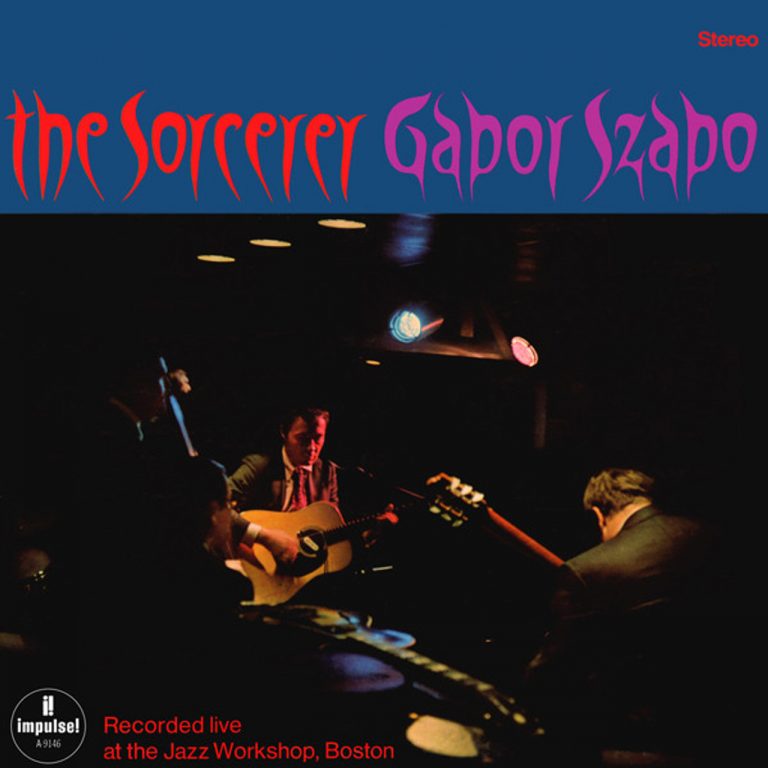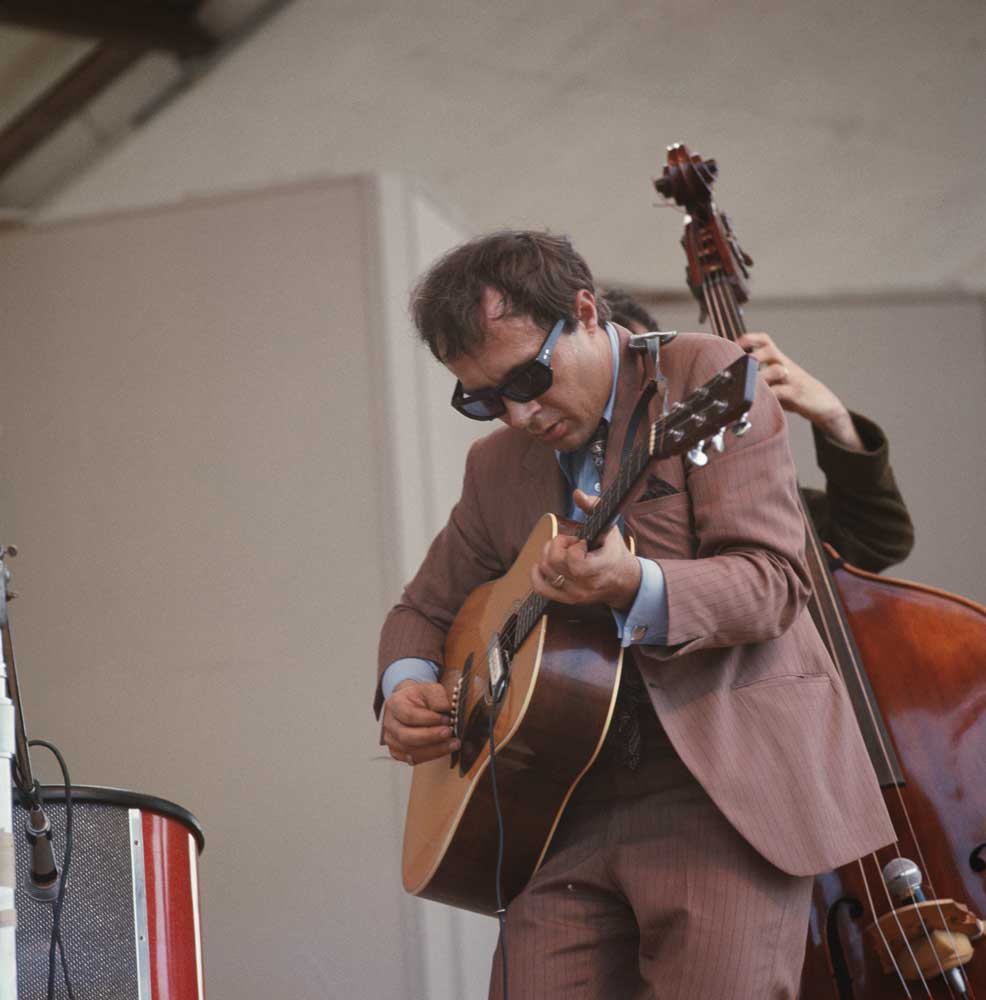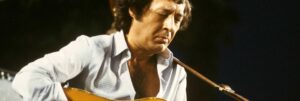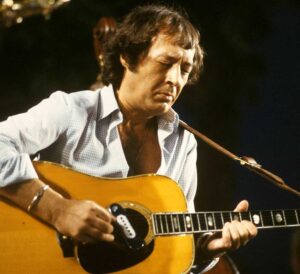Encouraged to develop his own style of guitar playing by drummer Chico Hamilton, whose quintet he joined in 1966, Hungarian/American Gábor Szabó created jazz for the flower power era in much the same way as another Hamilton sideman Charles Lloyd whose groups Szabó would also appear in.
That unique metallic and spacey sound that existed at the crossroads of jazz, psychedelic rock, easy listening and the music of his native Hungary, came to fruition during a prolific period between 1966-67 when he recorded eight albums with producer Bob Thiele for Impulse!. Of those albums it is perhaps the live recording before the hip crowd at Fred Taylor’s Jazz Workshop in Boston in 1967 “The Sorcerer” that best showcases the playing and compositional innovation of Szabó.

GABOR SZABO The Sorcerer
Available to purchase from our US store.Settling in California after moving to Austria from Budapest during the Communist takeover of Hungary in 1956, Gábor Szabó went on to study at Berklee College of Music in Boston between 1958 and 1960, before moving back to the West Coast.
It was there the guitarist was invited into the group of Chico Hamilton who he’d met at Newport Jazz Festival in 1958 going on to appear on the drummer’s string of albums for Impulse! “Man of Two Worlds”, “Chic* Chic Chico”, and “El Chico”. His biggest contribution was on the latter, where Szabó rose to the challenge of the bandleader creating his trademark spaced out guitar sound on the Latin jazz of “Conquistadores” and bringing an Eastern touch to Hamilton’s modal masterpiece ‘El Moors’.

After joining the quintet of vibes player Gary McFarland and Charles Lloyd’s quartet (appearing on his 1965 album for Columbia “Of Course, Of Course” alongside bassist Ron Carter and drummer Tony Williams), Szabó released his debut under his own name for Impulse!. With covers of The Beatles “Yesterday” and Bacharach and David’s “Walk On By”, “Gypsy 66” demonstrated Szabó’s skill with reinterpretation while the title track showed his more experimental side. The Rudy Van Gelder engineered session laid out his vision of straddling pop and more exploratory corners on his subsequent albums for Impulse!
Those albums included “Spellbinder” with Chico Hamilton and Ron Carter, another two with label mate Gary McFarland, the Indo-fusion album “Jazz Raga” and two LPs with Bob Thiele’s flower power vocal ensemble The California Dreamers. After this prolific surge, Szabó took a step back to create a new quintet with fellow guitarist Jimmy Stewart, his Hungarian friend Louis Kabok on bass, Hal Gordon on percussion and a variety of drummers including Marty Morell.
Szabó’s creative vision was unveiled on two nights at the Jazz Workshop, Boston, on April 14-15, 1967 a few months before the group supported Jimi Hendrix and Jefferson Airplane at The Fillmore in San Francisco. The unusual jazz line up of two guitars, bass, drums and percussion was captured by engineer and live recording pioneer Reice Hamel in his custom built VW bus mobile recording studio parked outside the Jazz Workshop.
Of his own playing Szabó told Guitar Player magazine in October 1969. “I let the pick kind of slide on the strings and that gets the metallic sound. The left hand has to be firm and you have to press quite hard on the strings so that there will be no buzz , keeping the sound clean.” In Jimmy Stewart, who he had met at the North Beach club Hungry I in the early 1960s, Szabó found a guitarist with whom he could instinctively work, whether trading solos or improvising with counterpoint. “You have to be multi-sensitive to communicate at this level. Your instrumental technique must be world class. Your ability to respond has to be instantaneous to the mood. And you must have a sense of drama,” Stewart told Wax Poetics magazine in 2005.
The intuition and drama of which Stewart speaks is evident right from the opening number, a version of Sonny Bono’s “A Beat Goes On”, performed around the same time as the famous Buddy Rich take. But it’s on the Stewart composition “Lou-ise” that the partnership takes flight, with their breathtaking interplay supported by the killer drum breaks of Marty Morell. The album’s highpoint is when the group reach into experimental territory on the Middle-Eastern tones of “Space”. On this and the equally heady “Mizrab”, Szabó’s Martin D-45 lead parts and Stewart’s nylon string textures create what Stewart described to Wax Poetics as “on the spot, magical music.”
Such was the success of “The Sorcerer” (now pressed on 180-gram vinyl at Third Man in Detroit as part of the Verve By Request series) that Impulse! quickly released another album of tracks recorded at The Jazz Workshop on those two nights in 1967 under the name “More Sorcery”. Like the best live albums these Impulse! recordings offer a fascinating window into pure artistry as it unfolded.
Andy Thomas is a London based writer who has contributed regularly to Straight No Chaser, Wax Poetics, We Jazz, Red Bull Music Academy, and Bandcamp Daily. He has also written liner notes for Strut, Soul Jazz and Brownswood Recordings.
Header photo: Gábor Szabó. Photo: David Redfern / Redferns.


